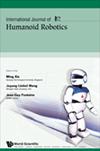Electrically Active Interface Defects in the (100)Si/SiOx/HfO2/TiN System: Origin, Instabilities and Passivation
IF 0.9
4区 计算机科学
Q4 ROBOTICS
引用次数: 5
Abstract
An analysis of the origin and passivation of interface states in (100)Si/SiOx/HfO2/TiN capacitor structures is presented. For high-k gate/metal gate capacitors which exhibit relatively high interface state densities (> 1x1011cm-2) the dominant interfacial defects are silicon dangling bond (Pbo) centres. For (100)Si/SiOx/HfO2/TiN capacitors which experience no high temperature thermal budget following HfO2/TiN gate formation (T<600{degree sign}C), the devices exhibit instabilities, where the interface state densities are modified during electrical measurements. The origin of this instability is studied. The response of the interface state density to rapid thermal annealing (30s) in N2 over the temperature range 600-900{degree sign}C is presented. In addition, results are presented for interface state passivation in forming gas (0.5H2/0.95N2) from 350-550{degree sign}C for (100)Si/SiOx/HfO2/TiN gate stacks with no post deposition annealing following TiN gate formation and for devices following a 900{degree sign}C, 30s N2 RTA.(100)Si/SiOx/HfO2/TiN体系中的电活性界面缺陷:起源、不稳定性和钝化
分析了(100)Si/SiOx/HfO2/TiN电容结构中界面态的来源和钝化。对于具有较高界面态密度(bbb1x1011cm -2)的高k栅极/金属栅极电容器,主要的界面缺陷是硅悬空键(Pbo)中心。对于(100)Si/SiOx/HfO2/TiN电容器,在HfO2/TiN栅极形成后没有高温热收支(T<600{度符号}C),器件表现出不稳定性,其中在电测量期间界面态密度被修改。研究了这种不稳定性的根源。给出了在600 ~ 900{度符号}C的N2中快速退火(30s)对界面态密度的响应。此外,对于(100)Si/SiOx/HfO2/TiN栅极堆,在350-550{度符号}C的形成气体(0.5H2/0.95N2)中,在TiN栅极形成后没有沉积后退火,以及对于900{度符号}C, 30s N2 RTA的器件,给出了界面态钝化的结果。
本文章由计算机程序翻译,如有差异,请以英文原文为准。
求助全文
约1分钟内获得全文
求助全文
来源期刊
CiteScore
3.50
自引率
13.30%
发文量
29
审稿时长
6 months
期刊介绍:
The International Journal of Humanoid Robotics (IJHR) covers all subjects on the mind and body of humanoid robots. It is dedicated to advancing new theories, new techniques, and new implementations contributing to the successful achievement of future robots which not only imitate human beings, but also serve human beings. While IJHR encourages the contribution of original papers which are solidly grounded on proven theories or experimental procedures, the journal also encourages the contribution of innovative papers which venture into the new, frontier areas in robotics. Such papers need not necessarily demonstrate, in the early stages of research and development, the full potential of new findings on a physical or virtual robot.
IJHR welcomes original papers in the following categories:
Research papers, which disseminate scientific findings contributing to solving technical issues underlying the development of humanoid robots, or biologically-inspired robots, having multiple functionality related to either physical capabilities (i.e. motion) or mental capabilities (i.e. intelligence)
Review articles, which describe, in non-technical terms, the latest in basic theories, principles, and algorithmic solutions
Short articles (e.g. feature articles and dialogues), which discuss the latest significant achievements and the future trends in robotics R&D
Papers on curriculum development in humanoid robot education
Book reviews.

 求助内容:
求助内容: 应助结果提醒方式:
应助结果提醒方式:


